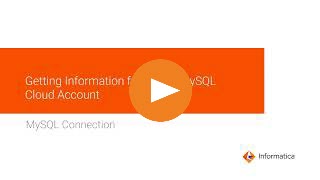
Operation | Support |
|---|---|
Read | Yes |
Write | Yes |

Property | Description |
|---|---|
Connection Name | Name of the connection. Each connection name must be unique within the organization. Connection names can contain alphanumeric characters, spaces, and the following special characters: _ . + -, Maximum length is 255 characters. |
User Name | User name for the database login. The user name can't contain a semicolon. |
Password | Password for the database login. The password can't contain a semicolon. |
Host | Name of the machine that hosts the database server. |
Port | Network port number used to connect to the database server. Default is 3306. |
Database Name | Name of the MySQL database that you want to connect to. Note: The database name is case-sensitive. Maximum length is 64 characters. Database name can contain alphanumeric and underscore characters. |
Code Page | The code page of the database server. |
Metadata Advanced Connection Properties | Additional properties for the JDBC driver to fetch the metadata. If you specify more than one property, separate each key-value pair with a semicolon. |
Runtime Advanced Connection Properties | Additional properties for the ODBC driver at runtime. If you specify more than one property, separate each key-value pair with a semicolon. |
Property | Description |
|---|---|
Pre SQL | Pre-SQL command that must be run before reading data from the source. |
Post SQL | Post-SQL command that must be run after reading data from the source. |
Output is Deterministic | Relational source or transformation output that does not change between session runs when the input data is consistent between runs. When you configure this property, the Secure Agent does not stage source data for recovery if transformations in the pipeline always produce repeatable data. |
Output is repeatable | Relational source or transformation output that is in the same order between session runs when the order of the input data is consistent. When output is deterministic and output is repeatable, the Secure Agent does not stage source data for recovery. |
SQL Override | The SQL statement to override the default query generated from the specified source type to read data from the MySQL Server source. |
Property | Description |
|---|---|
Forward Rejected Rows | Determines whether the transformation passes rejected rows to the next transformation or drops rejected rows. By default, the mapping task forwards rejected rows to the next transformation. If you select the Forward Rejected Rows option, the Secure Agent flags the rows for reject and writes them to the reject file. If you do not select the Forward Rejected Rows option, the Secure Agent drops the rejected rows and writes them to the session log file. The Secure Agent does not write the rejected rows to the reject file. |
Pre SQL | Pre-SQL command to run against the target database before writing data to the target. |
Post SQL | Post-SQL command to run against the target database after writing data to the target. |
Update Override | An update SQL statement that updates the data in a MySQL target table. The update SQL statement you specify overrides the default update statements that the Secure Agent generates to update the target based on key columns. You can define an update override statement to update target tables based on both key or non-key columns. In the override statement, you must enclose all reserved words in quotation marks. |
Reject file directory | The directory that stores the rejected files. Specify the directory where you want to store the rejected files. |
Reject filename | Name of the rejected file that is stored in the reject file directory. |
Schema Name | The schema name that overrides the schema name specified in the target connection. |